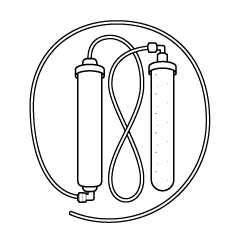Operating the Style C Siphon Filter
Setup and Operation

-
Find a container for the water you are going to filter. A rectangular, flat-bottomed container is best, but other types will work. Fill the container with clean (potable) water and drop the ceramic candle into the water. The position doesn't matter as long as the water will cover the candle.
Let it soak until it won't float before attempting to use it as a siphon filter. This may take an hour or so and it may take overnight. You can speed the process up by putting an object on top of it to hold it under water. (After the initial use of the ceramic candle, such extensive soaking will not be necessary.)
Important: If clean water is not available for soaking the candle, install the siphon adapter on the candle before soaking. (See next step for instructions.) Be sure to keep the open end of the tube well out of the water to avoid contamination.
-
Assemble the filter by screwing the female fitting attached to the tubing onto the male fitting of the ceramic candle. Be sure that the o-ring is inserted onto the stem of the candle. For added security and to assure the tightest seal possible, the threads of the candle should be taped with two or three wraps of teflon pipe thread tape, available at a good local hardware store. Tighten the fitting onto the candle until the o-ring is firmly against the shoulders of the fitting.
The hose can be trimmed to a convenient length, but keep in mind that the greater the elevation, the faster the production.
-
Select a container to receive the filtered water. Any clean container will work. (Actually, a dirty container will work, but you'll have to drink dirty water.)
-
Arrange the two containers so that the dirty water container is above the clean water container. The greater the difference in elevation, the faster the filter will work.
-
Start the filter by sucking water through the hose as if it were a soda straw until you get water in your mouth, then quickly lower the hose to allow water to flow into the clean water container. Water should continue to flow. If it doesn't, repeat the process — several attempts may be necessary. (If you suck until your eyeballs pop out and can't get water to come through the candle, it means you ignored the presoaking instructions in step 1.)
-
Once the filter has started, it will continue to filter water into the clean water container until the upper container runs out of water. Simply adding water to the upper container will restart the filter even if the container has run dry.
-
After the siphon is working well with the ceramic candle, add the carbon stage by simply pushing the end of the tube that is emitting water firmly into the “In” port of the carbon filter, and the final tube to the “Out” port of the carbon filter. (There may not be In/Out markings on the filter. Look at the directional flow arrow to determine the orientation.)
Water will flow through the carbon filter, out the tube and into your container. Be sure to let the water run for at least an hour before you begin to collect water you're going to drink. The carbon filter needs to rinse well. It is normal for black “fines” — carbon particles — to wash out of the carbon filter for some time. When the carbon filter is well rinsed, you can begin collecting water to drink.
Maintenance
The filter needs no maintenance as long as flow is good. When flow gets slower, clean the candle by holding it under running water and wiping it clean with a cloth or a mildly abrasive pad.
A ceramic filter will last indefinitely. It should be replaced when a significant amount of the outer surface has been worn away by cleaning, or when it becomes so filled with contaminants that cleaning doesn't restore normal water flow.
If your filter has a carbon inner core — a Doulton Super Sterasyl, for instance — it will have a shorter lifespan and should be replaced when the carbon is expended. Failure to improve the taste of water is an indication that replacement is needed for a carbon core cartridge.
Capability of Filter
Doulton ceramic cartridges are capable of making virtually any water safe to drink from a microbiological standpoint. They are not designed to remove heavy chemical contamination. You can filter pond water and drink it, but be selective. The clearer the water, the less cleaning you'll have to do, and the longer the filter will last.
If you use a carbon filter, for best results chlorinate the water lightly to be sure bacteria are killed. The carbon filter will remove chlorine and finish the job. Carbon filters usually require more pre-soaking than ceramics before use. Be patient. Weigh the cartridge down to hold it under water and don't waste your breath until it won't float.
Site Index
Filtration Systems
- Aeration for Iron & Sulfide
- Backwashing Filters
(whole house & well units)
- Chlorine & Chemical Injectors
- Countertop Water Filters
- Emergency Filters
- Garden Hose Filters
- Reverse Osmosis, Residential
- Reverse Osmosis, Commercial
- Shower Filters
- Specialty Filters
- Ultraviolet Systems
- Undersink Filters
- Water Softeners
- Whole House Filters
Cartridges
Parts
- Replacement Parts
- Faucets
- Filter Media
- Fittings
- Housings
- O-rings
- Pumps
- Pura UV
- R.O. Parts
- R.O. Tanks
- R.O. Booster Pump
- VIQUA UV